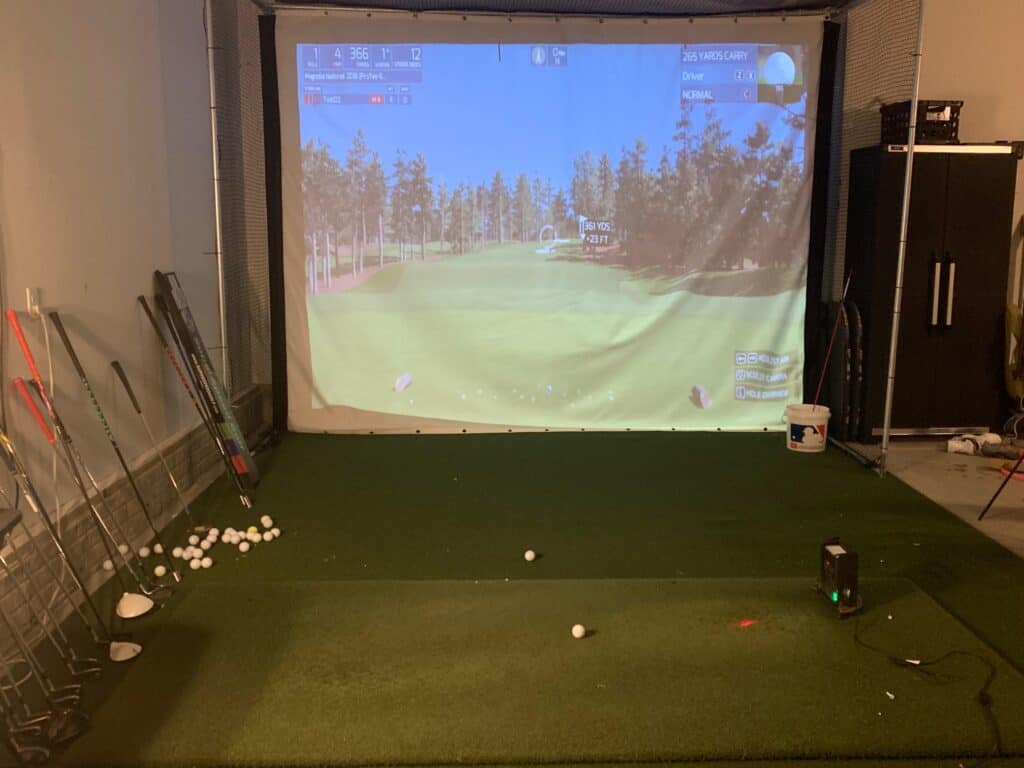Golfers typically have one of three problems 1) their center is too far behind the ball, 2) they sway too far forward or 3) they get tentative through the shot.
We have all been there!
Standing over a 100 yard wedge shot with a water hazard just short of the green, we make what feels like a decent swing, but we hit the golf ball fat and it comes up short and lands in the water.
The round in many cases is ruined and our ego is destroyed. How can we not hit a wedge solid and on the green and give ourselves a chance for birdie?
Golf can be a frustrating game, especially when we don’t know why something happens.
Today, our goal is to help you understand the fat shot with the wedges so you can make the necessary adjustments to strike the ball solid and give yourself that birdie putt!
Why Do I Hit My Wedges Fat?
My Journey: I have found #3 to be the main reason. When I get tentative due to a shorter wedge distance, I can tend to hit the ball a touch fat. The key is to have the main swing through to keep moving through the shot. If you keep moving through the shot, you chances of hitting it solid increase significantly! Keep everything moving: body, arms and chest! Finish through the shot!
After we dive into each of these three potential causes, we will provide a solution for each problem and then end with two quality drills to help your ball striking and controlling the start line and curve of your golf ball.
These are two key essentials to any club in the bag, but even more important with a wedge in your hand when you are trying to score!

Cause #1: Center Too Far Behind the Ball
There are typically two types of golf swing when it comes to weight shift or pressure shift in the golf swing. There are golfers that move off the ball and then back to the front foot when striking the ball or those golfers that keep everything centered throughout the shot with very little shifting of the body or the head.
In the first swing, on video, we often see a golfer that shifts back with his or her head and middle of their chest. They then re-center at the at the beginning of the downswing and strike the ball.
In the second swing, on video, we see a turning like motion instead of a shifting move, where the head and the sternum stay centered and even sometimes loaded on the front leg for a swing with the wedge.
If you fall into the category of the first swing, there is a chance you might not fully re-center in the beginning of the downswing and get caught with your weight too far back or your head too far back by the time you get to impact. The golfer in this situation might release the hands early to try to catch up and time it up perfectly one time and then fat it the next time.
Solution #1: Load 60% in Front Leg
The fix to this swing issue is to load 60% of your weight on your front foot at setup, keep your head and sternum centered in the backswing and then increase the amount of weight on the frost side through impact on the downswing.
The golfer can better control the low point of the golf swing as it will often follow where the weight is in the golf swing. The common misconception is that you will lose distance, when in fact you will maintain your distance and improve your ball striking consistency! Keep the swing simple, especially with a wedge in your hand.

Cause #2: Sway Too Far Forward
The 2nd potential issue for a golfer is swaying too far forward in the downswing. This is often the opposite of the first cause described above. Here, the golfer can be anxious from the top of the swing and the body moves too far forward causing an early release and bottoming the club out well before the ball, resulting in a fat wedge shot.
This can often be the result of an incomplete backswing or a rushing of the downswing through the shot. Stay patient, load that front side, and turn back and through.
Solution #2: Keep Head At the Golf Ball
For this golfer, the simple thought of seeing the back of the ball at impact can help keep the head centered and from shifting too far forward. The golfer, like the one above, can load up 60% of the swing and attempt to keep everything centered on the backswing and downswing.
Ultimately, golfers are going to control their low point better when there is less shifting in the backswing and less shifting in the downswing. Keep it simple!
Should I use a golf rangefinder?

Cause #3: Tentative Through the Shot
There are several reasons why a golfer can get tentative through the hitting zone:
- Fear of making poor contact
- Fear of hitting the ball too far
- Lack of confidence in the club selection
For many golfers throughout life, they try to control every single element of everything that happens in life. When we take this same mentality to the golf course, we can attempt to over control every little portion of our golf game. This can lead to uncertainty and tentativeness through the swing.
Solution #3: Commit to the Shot
If you reflect on your round upon completion and asked yourself to chart the following:
- Percent of quality shots when committed
- Percent of quality shots when questioning or tentative
You will find that you hit so many better shots when you commit to the shot. It allows you to swing tension free and make a committed swing. The tentative swing is often tension filled and this is disastrous with the wedge and can lead to poor contact.
How can I improve my distance control in golf?
You actually gain control by not trying to control everything.
- Decide on the best shot
- Match the club with the shot your envision
- Pick a target beyond the final destination
- Make and athletic motion back and throughout without tension towards that target
- Enjoy the game of golf once again!

#1 Recommended Drill for Fat Wedge Shots
Low Point Control Drill
- Take some yard paint and paint a 1-2 yard long line.
- Setup with 55% of your weight on your front side.
- Try to hit the target side of the line and see how many times out of 10 you can do this successfully!
- Repeat this drill every day for a month, tracking your progress and your ability to do this successfully in trials of ten.
- You may need to start with half swing and progress to full swings.
If you are struggling, put more weight forward and work on keeping your head still to help control the low point in the swing.
Once you have dialed in your contact and have controlled your low point, we have a bonus drill for you!
Stock Shot Drill
- At the driving range, set up an alignment stick about 6-8 yards in front of you, straight down your target line.
- If you have a second alignment stick, set the stick 3-4 feet right of the first stick (for a draw) or left of the first stick (for a fade).
- Complete your initial assessment to see how many times out of 10 you can start the ball to the right or left of your target. Pick one side and measure your game at this point.
- The goal is to eventually complete this successfully 7 out of 10 times!
Bonus Tip: Manage Your Expectations
Did you know the following?
- The average proximity to the pin from 100 yards on the PGA Tour is 18 feet.
- An 8 index from 100 yards in the fairway is more likely to miss the green, than hit the green and be within 20 feet of the hole.
- A 5 handicap golfer from 125 yards in the fairway has a 62% chance of hitting the green.
What we see too often is a golfer will hit a shot from 100 yards to 25 and be really upset on their distance from the hole. When instead, if they knew some of the stats above, they would realize that it is a decent shot. Not every wedge shot is going to fly and stop within 5 feet of the hole. Be kind to yourself and enjoy the journey for game improvement!
The more you can work on the two drills above, the more you will be able to play better golf.
- #1 Hit the ball solid
- #2 Control your start line and curve of the ball
Golf becomes fun to play and managing your way around the course can provide great satisfaction and game improvement!
Other Wedge Related Posts:
- How to flight your wedges down
- Why do I push my wedges?
- Why do I pull my wedges left?
- 54 vs 56 degree wedge

My Secret To Golf Improvement
Let’s face it, in order to get really good at golf, we must practice frequently. About three years ago, I made the leap and invested in a golf simulator build for my garage. I went with a SkyTrak Launch Monitor and the TGC software and can now play over 100,000 courses including Augusta, Pebble Beach, Bethpage Black, Whistling Straits. St. Andrews and many other of the top 100 courses in the world.
This golf simulator setup, which is more affordable that you might imagine, has been a game changer. I can now play golf everyday of the year regardless of rain, snow, cold weather or time of day. I can practice or play rounds of golf. I can stand in the 11th fairway at Augusta and with the auto-rewind feature I am able to practice my approach shots from various differences.
It is worth checking out through Rain or Shine Golf as they offer some incredible packages along with financing offers that are difficult to beat.
Some direct links to Rain or Shine Golf for pricing and financing:
Take Action – What You Can Do Today to Get Better
What does this mean for you? I believe in the following recipe to get better:
1 – Improve your motion in the golf swing by identifying a golf instructor. Here are some options:
Here is a list of golf instructors that we have reviewed:
2 – Train to swing faster and improve your swing speed. Here are some options:
Looking to gain more Speed and Distance in your swing. Two Options:
3 – Understand course strategy and work to break through your next barrier. Here is a series on breaking through:
We have provided guides on how to break 100, 90, 80 and 70. Check out more below, if interested.
4 – Practice Frequently
Did you know that I build a golf simulator in my garage and have played over 500 rounds of golf on my SkyTrak system? It has been a game changer and one worth checking out. Here are some of my other posts on golf simulators frequently asked questions:
- Is a Golf Simulator Worth It?
- How to Build a Golf Simulator?
- What is the Best Golf Simulator?
- Golf Simulator Accessories?
- How to Build a Golf Simulator for under $7000
- Top 11 Reasons to Buy a SkyTrak
- How to Build a Golf Simulator for Under $1000
- Why Build A Golf Simulator?
- What Space is Needed?
- Can A Golf Simulator Improve My Game?
- How Much Does A Golf Simulator Cost?
- Don’t Forget to Check out our 15 best golf swings of all time.
